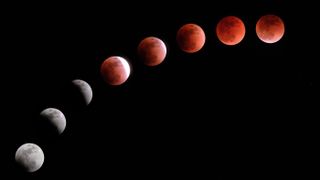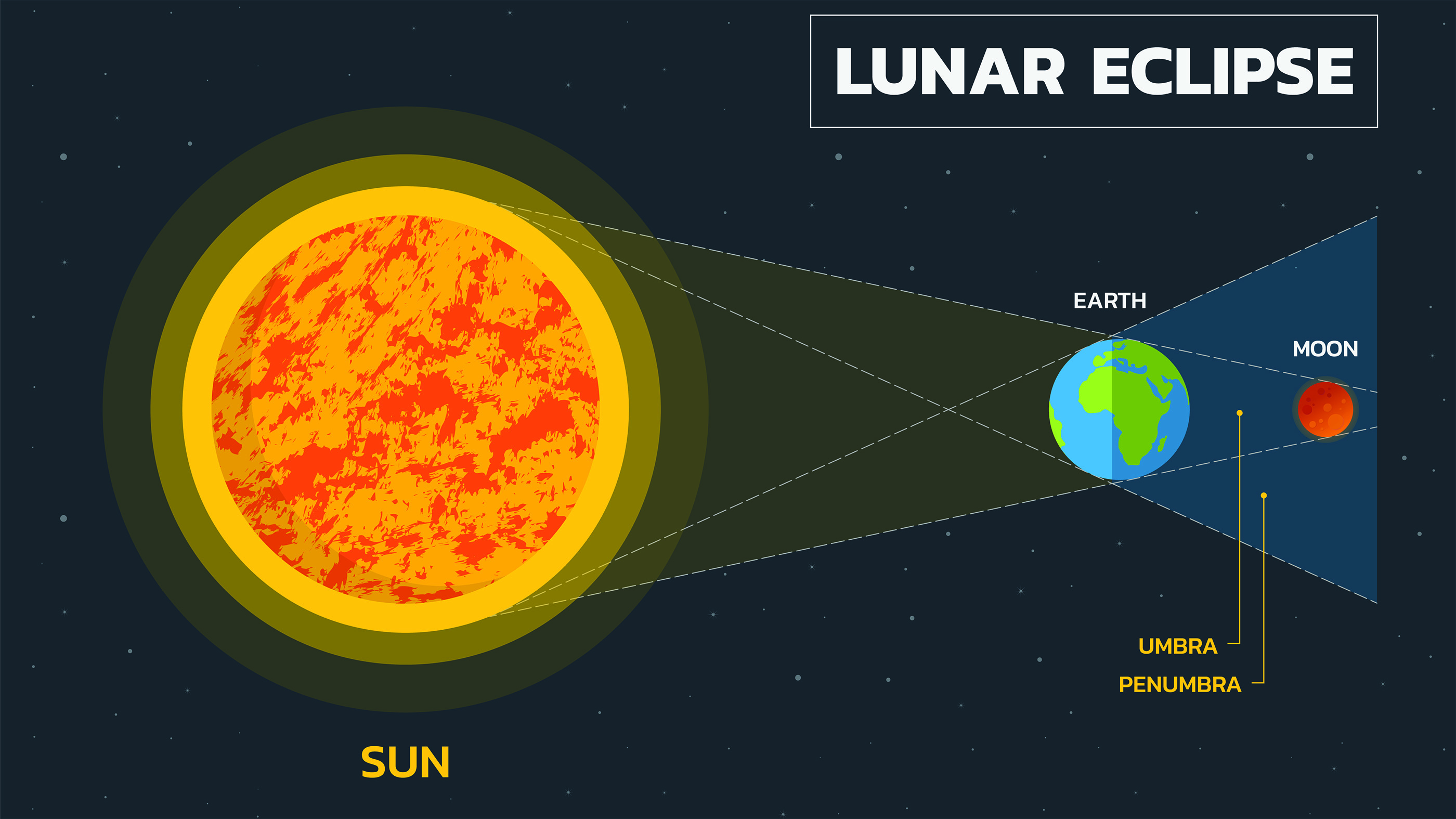When My Blue Moon Turns Red Again Japan
Why does the moon turn ruby-red during a total lunar eclipse?

During a lunar eclipse, the face of the moon will turn a shade of red.
The fiery glow is nearly dramatic during a total lunar eclipse, but fifty-fifty during partial and penumbral lunar eclipses, our lone satellite is cast an auburn colour.
When the moon tiptoes into the outer portion of Earth'due south shadow, becoming totally bathed in the darkest office of that shadow, why isn't the issue a "lights out" for the sky? Why instead does the moon go engulfed in a low-cal-orangish to blood-ruddy glow?
Perchance counterintuitively, the miracle that explains why the heaven is blue is the same i that turns our moon crimson during a lunar eclipse. It'south called Rayleigh scattering, or the preferential handful of certain wavelengths of light off of teensy particles — those about one-tenth the wavelength of the light or smaller. During the twenty-four hours, the sun'south light waves — which are made upward of a swath of colors corresponding to their individual wavelengths — get filtered through our atmosphere, where the tiny nitrogen and oxygen gas molecules allow the longer wavelengths such as reds, oranges and yellows, pass through straight to the ground (missing our line of sight). But the shorter wavelengths — such as violets and blues — get absorbed and and then scattered every which way, giving them more chances to hit our eyes.

Hither'south how that aforementioned light-scattering phenomenon makes our moon expect red. During a total lunar eclipse, the dominicus, Earth and moon are perfectly lined up in that lodge. When the Earth is direct in front of the sun, it blocks the dominicus's rays from lighting upward the moon. At that moment, you would meet a ring of lite around the moon, considering even though our planet is way bigger than the sun, our dwelling star'south light bends around the edges of Earth. This calorie-free gets reflected onto the moon.
"The darkened terrestrial disk is ringed by every sunrise and every sunset in the world, all at once," co-ordinate to NASA. However, the sun's lite must laissez passer through Earth's atmosphere before it hits the moon. Along the way, the shorter-wavelength blueish light gets scattered about before reaching the moon, leaving the reds and oranges unscathed to bathe the moon's surface. And voila, a red moon.

Sunrises and sunsets take on reddish hues for this reason: "When the sunday is higher in the sky during the day, the ruby-red lite passe[southward] directly through to the basis. While blue light gets scattered and therefore is more probable to be in your line of sight," astronomer Shannon Schmoll, director of Abrams Planetarium at Michigan State University, told Live Scientific discipline in an email. "At sunset, since the sun is low in the heaven, the reddish light passes through into your line of sight, while the blueish go[south] scattered away from it."
The moon will change various shades during different stages of a total lunar eclipse, morphing from an initial grayish to orange and amber. Atmospheric conditions can also affect the brightness of the colors. For instance, extra particles in the atmosphere, such as ash from a large wildfire or a recent volcanic eruption, may cause the moon to appear a darker shade of cherry, co-ordinate to NASA.
The moon doesn't ever hide completely behind Earth's shadow. During fractional lunar eclipses, the sun, Earth and moon are slightly off in their alignment, and and so our planet's shadow engulfs only part of the moon.
A novice skywatcher might not even notice the third type of lunar eclipse, the penumbral kind, in which the moon sits in Earth's penumbra, or its faint outer shadow.
To see this atmospheric science in activeness, expect no farther than the longest partial lunar eclipse of the century, which is due to grace the skies betwixt Nov. 18 and. xix. The fiery moon volition be visible in all 50 U.S. states.
The next 2 lunar eclipses will exist full eclipses and will occur on May 16, 2022 (visible in the Americas, Europe and Africa), followed past one on November. 8, 2022 (visible in Asia, Australia, the Pacific and the Americas), co-ordinate to NASA.
Editor's Note: This article was updated on November. 16, 2021.
Original article on Alive Science.
Source: https://www.livescience.com/33627-moon-red-orange-lunar-eclipse.html
0 Response to "When My Blue Moon Turns Red Again Japan"
Post a Comment